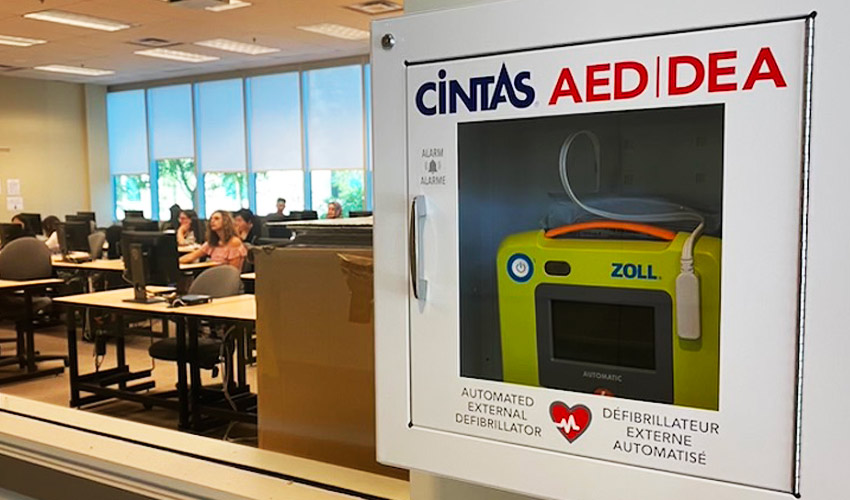Making every second count
University adds more automated external defibrillators to increase safety on campus
— Mount Royal University | Posted: July 27, 2022

The units are in wall-mounted cabinets with signage above.
When someone’s heart stops beating, every second counts. That’s why Mount Royal University is increasing the number of automated external defibrillators (AEDs) stationed throughout campus.
An estimated 35,000 cardiac arrests happen across the country every year, according to the Heart and Stroke Foundation of Canada, and few survive. Survival rates, however, double if someone performs CPR and uses an automated external defibrillator (AED).
“Increasing the number of these life-saving machines contributes to the overall health and safety of our campus community. These 11 new units, in addition to the four that are replacing older models, mean that critical help is that much closer — and that much faster — when someone needs it,” says Peter Davison, chief safety and risk officer with Safety and Risk at Mount Royal.
“The electronic step-by-step instructions delivered via audio and video mean those nearby are empowered to provide treatment that can mean the difference between life and death.”
The 15 units will be installed by the end of July. The new AEDs can be used on both adults and children, an important feature given the variety of people on campus, from children taking lessons at the Conservatory to seniors working out at Recreation. The ZOLL AED 3 unit was chosen for its ease of use, says Environmental Health and Safety (EH&S) manager Rob Siklodi.
“Everything needed is right there. The units talk the user through the process of preparing the patient — including removing or cutting away clothing and shaving hair so the pads can properly attach to the patient — and applying the AED pads in the right locations,” Siklodi says.
“Once the pads are in place, the AED continues to talk the responder through the process of chest compressions and checking for heart electrical activity.”
How it works
AEDs detect when the heart isn't working properly. If the machine does detect abnormal electrical activity in the patient's heart, it shocks the heart to get it beating normally again. Siklodi likens it to turning the power off and then on again on your computer when it stops accepting input from the keyboard or mouse. AEDs do not shock the heart if there is no electrical activity — that's why it's important to know how to perform CPR to help keep blood circulating in the patient until EMS arrives.
The machines’ ability to save lives was demonstrated on campus in 2014. Ayaz Kara suffered a heart attack in the men’s locker room in the Recreation building. His heart stopped. Rec staff and a student performed CPR and used an AED to restart Kara’s heart. Three weeks after the incident, Kara contributed five AEDs to Mount Royal. The on-campus AEDs are checked monthly by Security, and also come with self-diagnostics that activate an audible signal if something needs to be fixed or replaced.
Accessibility and knowledge key safety components
The process to increase the number of units on campus began in 2021. Early on, Residence was identified as requiring AEDs. Each of the West Residence towers now has one located across from the elevators. The East Residence Community Centre has one located in the laundry room. Other areas on campus with AEDs include the EA and EB buildings. These units are each installed near the main entrances.
EH&S chose locations with a sobering fact in mind: brain damage starts to occur about four minutes after blood flow to the brain stops. The AED needs to be close enough to be retrieved within three minutes round-trip at a walking pace — to the machine and back to the location of the patient — so there is time to get it set up and get the heart beating again. Ideally, someone can perform CPR while the AED is retrieved, says Environmental Health and Safety’s Stuart Elle.
“There was a lot of walking — including stairwells — to determine the best places to locate the new units and ensure the existing units were properly located,” Elle says. “How long did it take to get from the furthest corners of a building to a possible central spot? Could one location be enough for several buildings? Are they accessible at all hours when they might be needed?”
The units are in wall-mounted cabinets with signage above. Safety and Risk encourages everyone to explore their environment on campus to know where things such as an AED, fire alarm pull stations, emergency exit routes, Code Blue stations, and so on, are located.
“When an emergency happens, knowing what resources are available and where they are is invaluable. Being prepared can save seconds. That valuable time can make a huge difference in avoiding injury or death in an emergency,” he says.
“Taking a few minutes now to familiarize yourself with the safety features around you really can make the difference between life and death.”
